
A Standard Missile-3 Block IA (SM-3 Blk IA) interceptor is launched from the USS CARL M. LEVIN (DDG 120) off the coast of Pacific Missile Range Facility in Kauai, Hawaii, as part of a joint test of the U.S. Navy Program Executive Office Integrated Warfare Systems and the Missile Defense Agency conducted October 25, 2023. (DVIDS)
WASHINGTON — The Missile Defense Agency began its next round of battle network upgrades with a bang, issuing three task orders worth a total of over $846.6 million to Lockheed Martin for services, software, and other aspects of what the company is calling C2BMC-Next.
The effort aims to improve MDA’s long-standing Command, Control, Battle Management, & Communications (C2BMC) network, which first went operational in 2004, by adding new satellite feeds and other sensors, streamlined interservice data-sharing and even AI algorithms.
The long-expected IDIQ contract, first announced last year and awarded Thursday, could be worth up to $4.1 billion over 10 years if MDA exercises all available options.
Lockheed’s been a lock for the sole-source contract since the start. “No other source has access to the required technical data and resident expertise to perform the described effort,” MDA said last year. The aerospace titan is the long-established incumbent on C2BMC.
C2BMC’s very longevity and complexity makes it a model for the Pentagon’s nascent CJADC2 initiative, a Combined Joint All-Domain Command & Control system intended to link, not just missile defenses, but all “sensors and shooters” from satellites to stealth fighters to submarines. That’s because the Pentagon decided years ago that replacing all its existing networks with one ring to rule them all was a technological and bureaucratic impossibility.
RELATED: First version of all-service battle network is ‘real and ready now’: Hicks
Instead the military would build up C2JADC2 as a kind of feudal confederation, an inter-service overlay to connect pre-existing and previously incompatible service-specific systems. The biggest such confederation already in service is C2BMC — whose version now under contract may well evolve into the Missile Defense Agency’s contribution to CJADC2, alongside the Army’s Project Convergence, the Navy’s Project Overmatch, and the Air Force’s ABMS.
“The Ballistic Missile Defense System, as a major defense acquisition program, is not actually ‘a’ system — it is a collection of systems, each with their own fire control loops,” explained Tom Karako, director of missile defense studies at the thinktank CSIS. “It’s not replacing every fire control system everywhere — it’s creating commonality, common data formats, so everyone can talk to each other better.”
The C2BMC battle network sits atop three major missile defense systems built by multiple contractors for three different parts of the military: the Army’s THAAD and accompanying AN/TPY-2 radar, the Ashore version of the Navy’s Aegis shipboard air & missile defense, and MDA’s own GMD (Ground-based Midcourse Defense).
RELATED: Next Generation Interceptor selection coming this month, MDA chief says
Each of these systems has its own missiles, command system, and links to radar, so it’s capable of functioning independently. But C2MBC allows them to share data with each other, with satellites and earth-based radars, and with commanders at 33 sites around the world. That, in turn, enables coordinated planning and defense against missile threats capable of crossing the globe in minutes, which no single sensor can track from launch to impact.
Under its C2BMC-Next initiative, Lockheed Martin aims to upgrade that network in multiple ways. That includes improved tracking of cruise missiles and hypersonic missiles, which both fly slower but more unpredictable courses than ballistic missiles. It also aims to add artificial intelligence/machine learning algorithms “to detect, track, target, engage and assess emerging threats” and even calculate defensive responses with “maximum coverage” to protect as many lives as possible.
“It’s a continuation of the current program that incorporates new elements that are being added in, such as NGI [Next Generation Interceptor], LRDR [Long Range Discrimination Radar], the forthcoming space sensor constellations, and so on.” Karako said. “Every time they add some new component, some new element, you’ve also got to work on the C2BMC piece so it can talk with everything else and support the larger system of systems.”






















